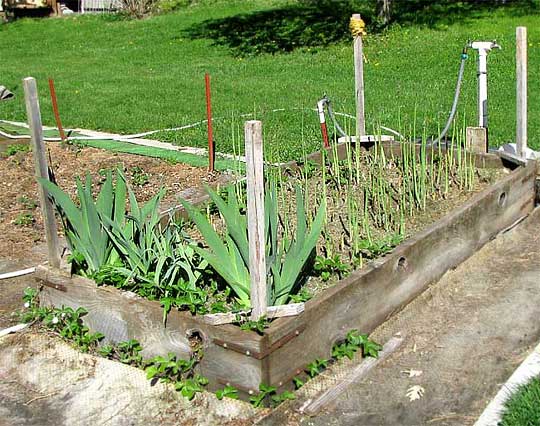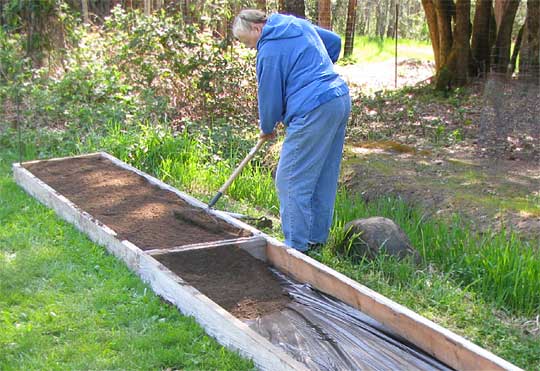 Notice these features of the above raised bed:
Notice these features of the above raised bed:- The side boards are securely held together
- A water source with a hose is nearby
- Old carpet is placed around the bed, keeping down weeds and providing a place to walk on
- The lowest board (bottom left in the photo) has a hole in it for drainage. The hole is covered with a screen to keep out rodents and other critters
- The four vertical poles serve mostly to tie strings to, to keep the asparagus later in the year from leaning over into the pathway; during the winter the poles may hold up plastic sheeting, converting the raised bed to a cold frame where lettuce, radishes, mustard greens and the like may be grown
Especially in towns soil may be so compacted, so nutritionally poor, so full of glass and pollutants... that raised beds may be the only way to garden. Here are some advantages of raised beds over regular gardening styles:
- Since you don't walk on raised beds, soil in them doesn't compact. In compacted soil, air and water don't circulate well, and garden plants need circulating air and water as much as we do.
- Raised beds drain well, helping plant roots to breathe. In some places with soggy soil, raised beds may be the only way to garden.
- Different plants require different soil types. If you have several raised beds, you can manage your soil differently from bed to bed, customizing soil to each plant grouping.
- Somehow having your garden spots raised and framed helps focus your attention on the plants, helping you monitor for pests, diseases, nutritional problems, etc.
Studies indicate that raised garden beds may produce 1.4 to 2 times as much vegetables and flowers per square foot as ordinary garden plots!
Below you can see what it looks like while constructing beds:

Notice the black plastic sheet beneath the dirt. That's a special kind of sheeting perforated with tiny holes so that water runs through it. Also the plastic helps keep critters, and tree and grass roots from entering from below.
In the background maybe you can see a wire fence to keep out animals. In many places deer, rabbits and the like will eat your plants long before the gardens produce a crop. If you're not sure whether you'll have animal problems, you need to talk to neighbors and maybe put up a fence. If you have deer problems, the fence will need to be tall indeed.
Finally, the soil you fill your raised beds with must be good for gardening. Below you can see some garden soil that just by looking at it you can tell that it's good:

Good gardening soil is loose and crumbly. It'll display tiny pieces of decaying plant material (organic matter) all through it. It'll be dark. If it gets wet, water will soak through it, but then the soil will remain moist (not wet) and spongy (not soupy or like putty) for a long time. Finally, it'll smell rich and musty. You'll know good-smelling garden soil when you smell it.